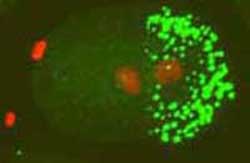Susan Strome
| Distinguished Professor of MCD Biology B.A., University of New Mexico, Albuquerque Ph.D., University of Washington, Seattle Postdoctorate, University of Colorado, Boulder |
Regulation of Germ Cell Development in C. elegans
Germ cells (the cells that give rise to eggs and sperm) have special properties. Their immortality allows them to be perpetuated from generation to generation, and their totipotency allows them to generate all of the diverse cell types of the body in each generation. Our lab investigates the molecular mechanisms used by germ cells to establish and maintain their identity, immortality, and totipotency. We study germ cells in the model organism C. elegans using a wide variety of approaches, including genetics, imaging, molecular biology, biochemistry, and whole-genome microarray and sequencing technologies. Our current focus areas are transmission of chromatin states and control of gene expression in germ cells, and regulation of RNA metabolism by germline-specific cytoplasmic "P granules".
Chromatin regulation: The MES proteins are histone methylating enzymes that are essential for germ cell identity and immortality. MES-4 and its H3Lys36 methyl marks are dramatically concentrated on the autosomes, while MES-2/3/6-catalyzed H3Lys27 methyl marks are preferentially on the X chromosomes. We are investigating how the MES proteins achieve their distinct distributions, how their patterns are transmitted across generations and through DNA replication, how they regulate gene expression and silencing of the X chromosomes in germ cells, and how they participate in specifying germ cell identity and instructing proper germ cell development.
P granule regulation: P granules are germline-specific RNA-protein complexes that overlie nuclear pores and extend the nuclear pore complex environment. We recently learned that P granules protect germ cell fate by antagonizing somatic cell fate. We are investigating the molecular basis for that role.
Please follow this link to find the lab's publications in the National Library of Medicine's PubMed database.

In the left panel, MES-4 (green) associates with the ten autosomes but not the two X chromosomes (arrows); DNA is red.

In the right panel, P granules (green) are being segregated to the germline daughter of this soon to be two-cell embryo; DNA is red.
